Underwear
Partisan Boxers
Just in time for the 2020 election, from the legendary Frederick's Of Hollywood.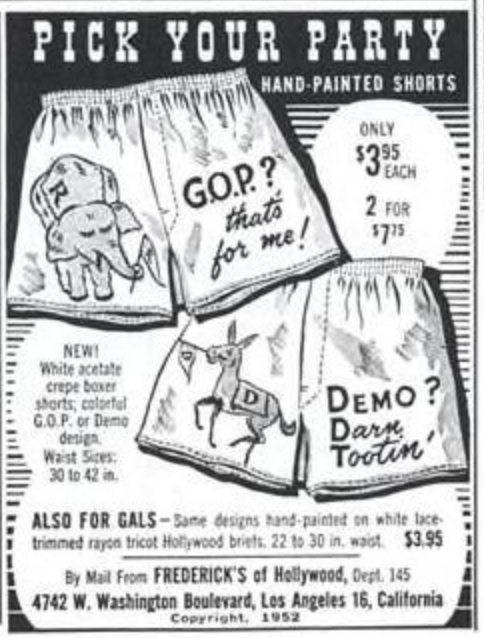
Ad source.
Posted By: Paul - Fri May 29, 2020 -
Comments (5)
Category: Animals, Politics, Underwear, 1950s
Medicated Under Vest
Not only a medical miracle but a fashion statement as well."has proven itself to be the very Perfection of Prevention from Pneumonia…. keeping the skin in a most delicious and healthy glow and the internal organs in that healthy and vigorous condition which is the Only Safeguard Against Disease."
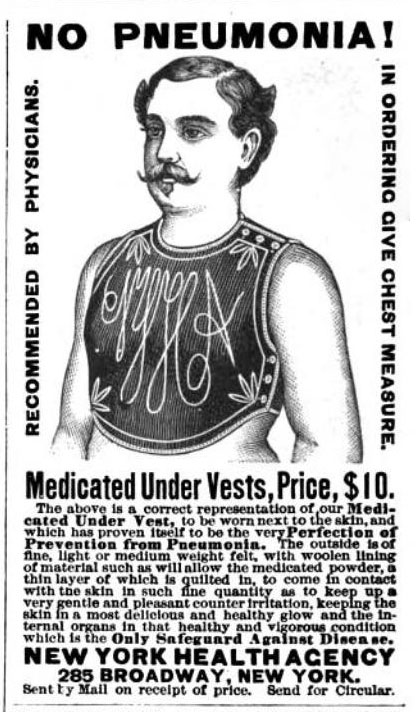
Posted By: Alex - Fri May 01, 2020 -
Comments (6)
Category: Fashion, Underwear, Health, Disease, Nineteenth Century
Undies Are Gossips!
LUX Soap's 1942 ad campaign warned of the danger of talking underwear.
Some analysis by Melissa McEuen in Making War, Making Women: Femininity and Duty on the American Home Front:
The "Undies Are Gossips" campaign radiated a core message familiar to Americans early in the war: the power of talk. U.S. government propaganda connected conversations with death and destruction for U.S. troops: "Somebody blabbed — button your lip!" and "A Careless Word… A Needless Sinking" warned viewers to check their conversations. One resonant quip suggested "Loose Lips Might Sink Ships."

Spokesman Review - Mar 1, 1942

Philadelphia Inquirer - July 19, 1942
Posted By: Alex - Sat Apr 25, 2020 -
Comments (3)
Category: Advertising, Underwear, 1940s
Follies of the Madmen #453
The wealthy always employ midgets to help them dress. Seriously, what size is that person standing on the chair? Maybe the gal in undergarments is a giant?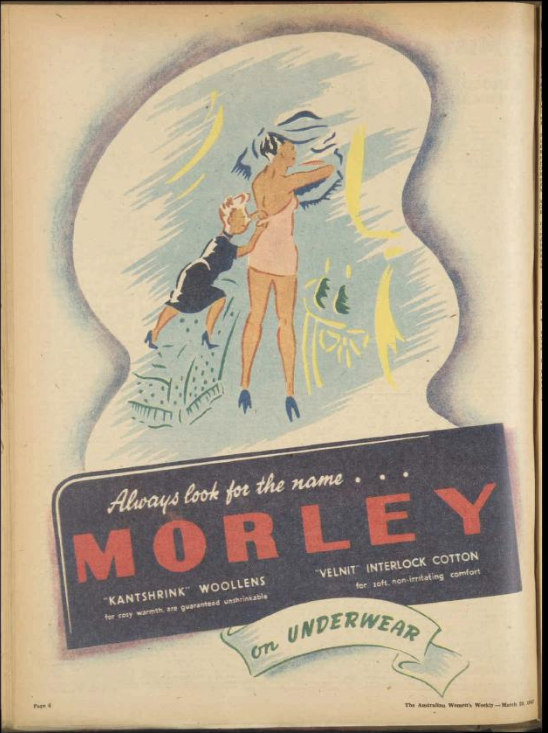
Source.
Posted By: Paul - Mon Nov 18, 2019 -
Comments (0)
Category: Ambiguity, Uncertainty and Deliberate Obscurity, Business, Advertising, Confusion, Misunderstanding, and Incomprehension, Excess, Overkill, Hyperbole and Too Much Is Not Enough, Surrealism, Underwear, 1940s
The Armageddon Bra
"the 'Armageddon Bra' includes a sensor on the shoulder strap, and a control box to warn of objects falling from the skies."
The Vancouver Province - May 13, 1999

Montreal Gazette - May 13, 1999
Posted By: Alex - Fri Nov 08, 2019 -
Comments (0)
Category: Fashion, Underwear, 1990s
Underwear on head in restaurant
“How would you like to be eating a hamburger and turn around and see some dude wearing jockey shorts on his head?”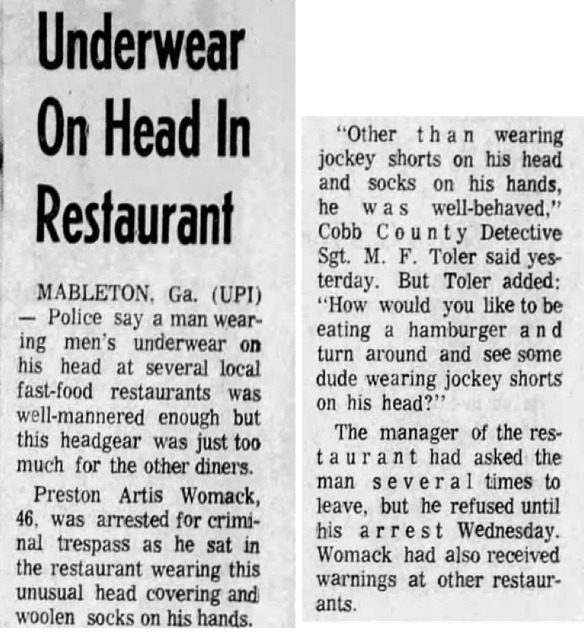
Indianapolis News - May 20, 1977
Posted By: Alex - Sat Oct 12, 2019 -
Comments (3)
Category: Eccentrics, Headgear, Underwear, 1970s
The Lice-Infested Underwear Experiment
During World War II, millions of men served their country by fighting in the military. Hundreds of thousands of others worked in hospitals or factories. And thirty-two men did their part by wearing lice-infested underwear.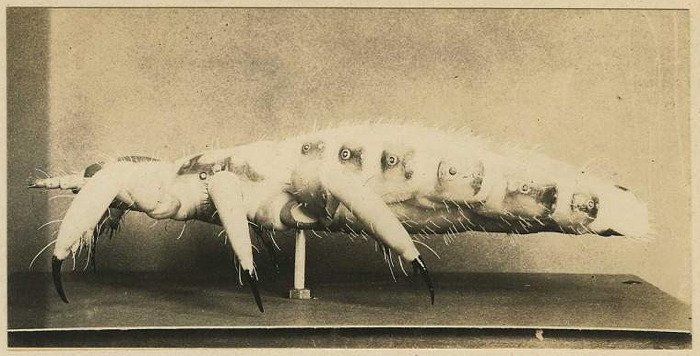
Model of a body louse, National Museum of Health and Medicine.
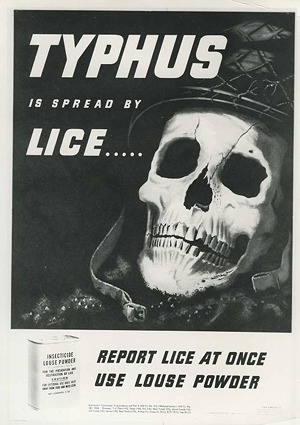
World War II public health warning
Source: Nat. Museum of Health & Medicine
In an attempt to prevent this, the Rockefeller Foundation, in collaboration with the federal government, funded the creation in 1942 of a Louse Lab whose purpose was to study the biology of the louse and to find an effective means of preventing infestation. The Lab, located in New York City, was headed by Dr. William A. Davis, a public health researcher, and Charles M. Wheeler, an entomologist.
The first task for the Louse Lab was to obtain a supply of lice. They achieved this by collecting lice off a patient in the alcoholic ward of Bellevue Hospital. Then they kept the lice alive by allowing them to feed on the arms of medical students (who had volunteered for the job). In this way, the lab soon had a colony of thousands of lice. They determined that the lice were free of disease since the med students didn't get sick.
Next they had to find human hosts willing to serve as subjects in experiments involving infestation in real-world conditions. For this they initially turned to homeless people living in the surrounding city, whom they paid $7 each in return for agreeing first to be infected by lice and next to test experimental anti-louse powders. Unfortunately, the homeless people proved to be uncooperative subjects who often didn't follow the instructions given to them. Frustrated, Davis and Wheeler began to search for other, more reliable subjects.
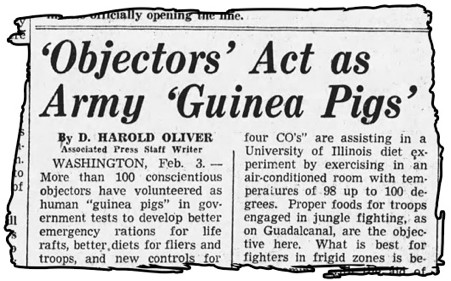
The Vancouver Sun - Feb 3, 1943
In theory, the COs were always given a choice about whether or not to serve as guinea pigs. In practice, it wasn't that simple. Controversy lingers about how voluntary their choice really was since their options were rather limited: be a guinea pig for science, or do back-breaking manual labor. But for their part, the COs have reported that they were often eager to volunteer for experiments. Sensitive to accusations that they were cowardly and unpatriotic, serving as a test subject offered the young men a chance to do something that seemed more heroic than manual labor.
Eventually COs participated in a wide variety of experiments, but Davis and Wheeler were the very first researchers to use American COs as experimental subjects. And they planned to infest these volunteers with lice.
More in extended >>
Posted By: Alex - Wed Sep 04, 2019 -
Comments (5)
Category: Health, Insects and Spiders, Experiments, Underwear, 1940s
Follies of the Madmen #422
"Takes a drenching, yet keeps on clenching!"
Posted By: Paul - Fri Apr 19, 2019 -
Comments (2)
Category: Business, Advertising, Family, Underwear, 1910s
Denim Panties
More denim weirdness. Designer Y/Project has come out with denim panties. On social media, people have nicknamed them “Janties” (short for Jeans Panties). They're available from retailer SSense, for $315. From their website:
Posted By: Alex - Mon Apr 08, 2019 -
Comments (7)
Category: Fashion, Underwear, Denim
Women of Canada Bras
Bra-maker Simons recently apologized for its line of bras named after prominent Canadian women. For example, they had the Beverley bralette, named after former Chief Justice of Canada Beverley McLachlin. The Flora, named after Flora Macdonald, Canada's first female minister of Foreign Affairs. And the Stella push-up bra, named after social activist Stella Lord, who fought against poverty in Nova Scotia.Some of the women are still living and hadn't been contacted for their consent. Plus, the link between lingerie and chief justices, social activists, etc. seemed unclear to just about everyone. Noted Marketing professor Ken Wong: "This is marketing at its worst... Somebody there probably said, 'We need to connect our product to this empowerment movement.' But what they failed to consider is will people find it offensive and insulting."
More details: msn.com
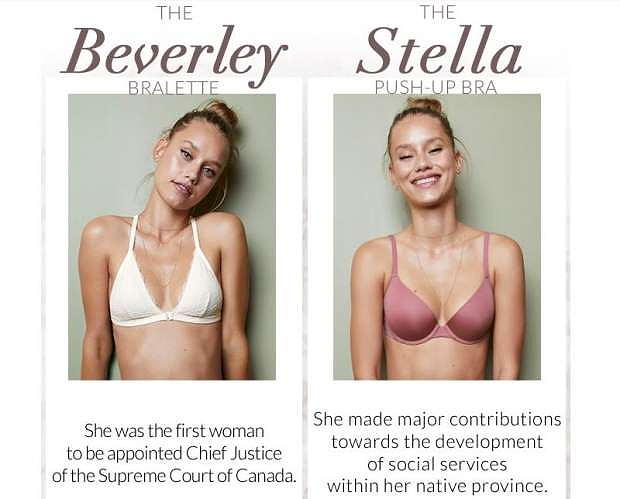
Posted By: Alex - Sun Apr 07, 2019 -
Comments (4)
Category: Advertising, Underwear

| Who We Are |
|---|
| Alex Boese Alex is the creator and curator of the Museum of Hoaxes. He's also the author of various weird, non-fiction, science-themed books such as Elephants on Acid and Psychedelic Apes. Paul Di Filippo Paul has been paid to put weird ideas into fictional form for over thirty years, in his career as a noted science fiction writer. He has recently begun blogging on many curious topics with three fellow writers at The Inferior 4+1. Contact Us |




